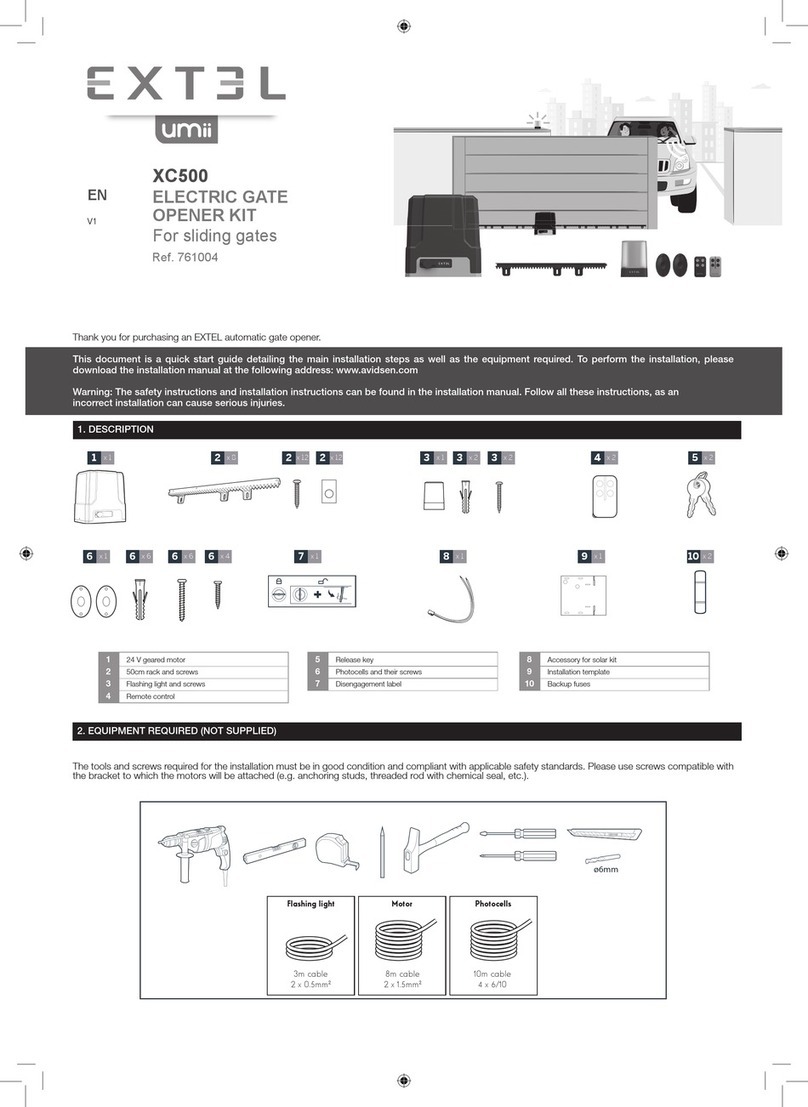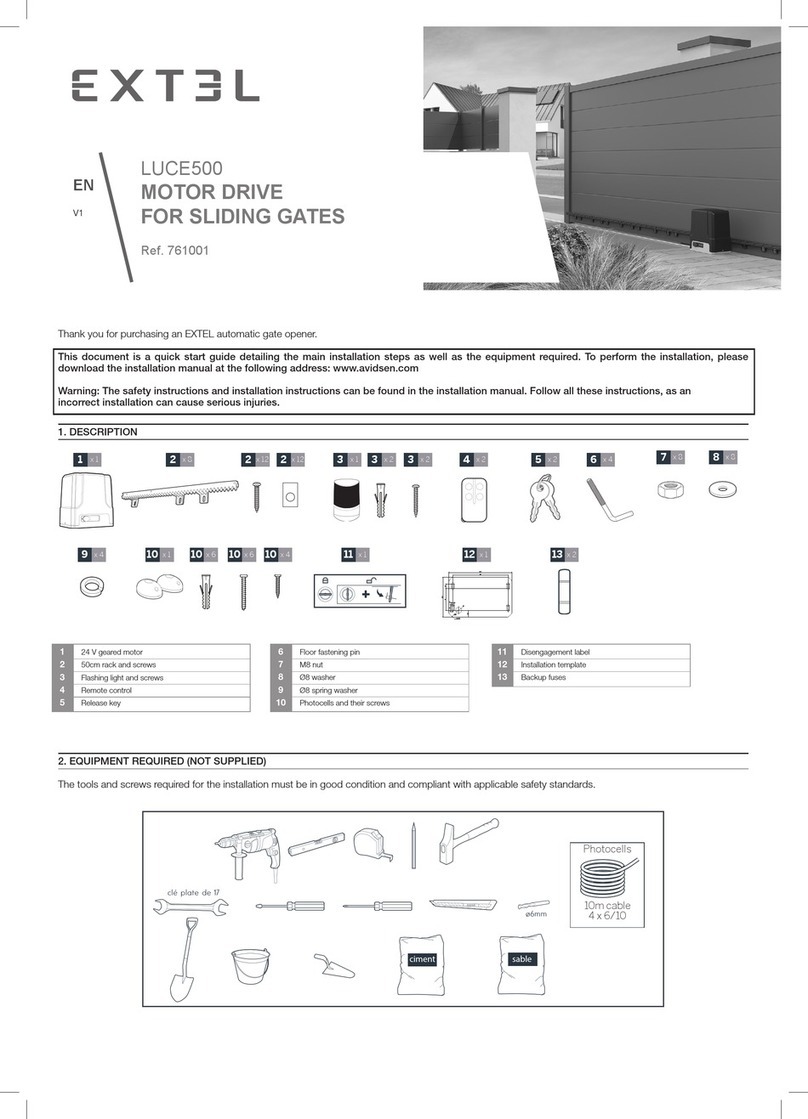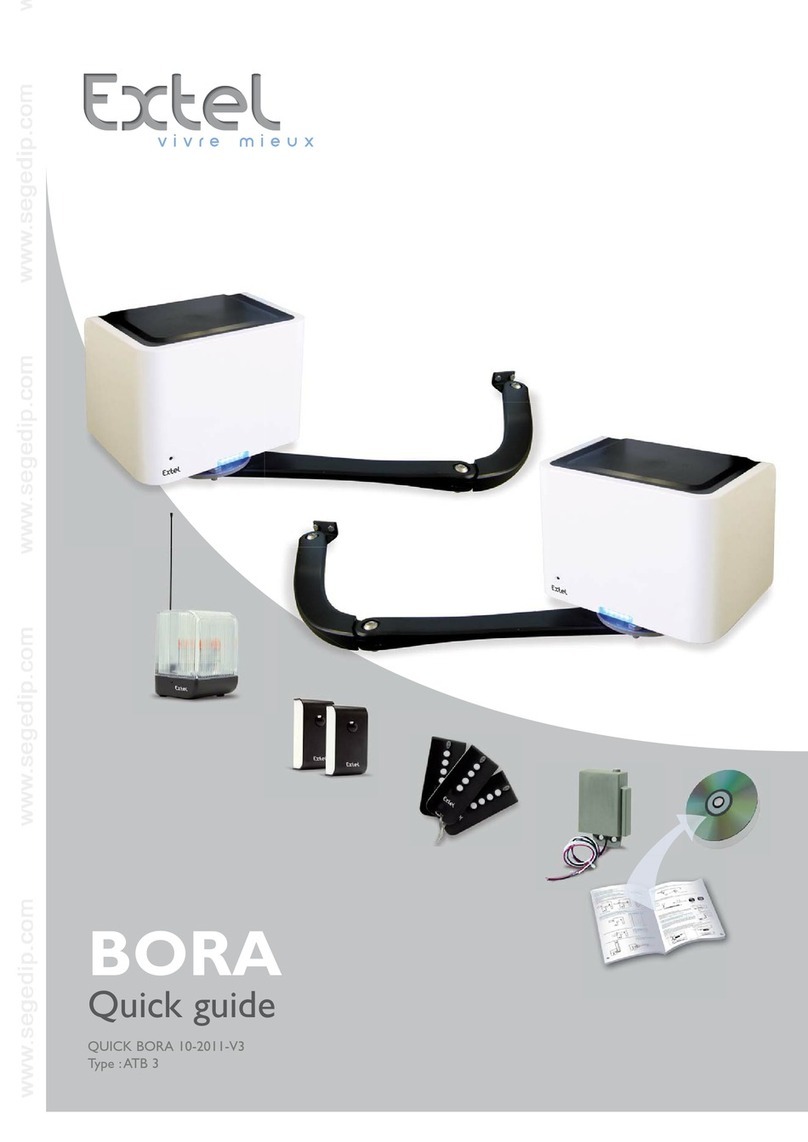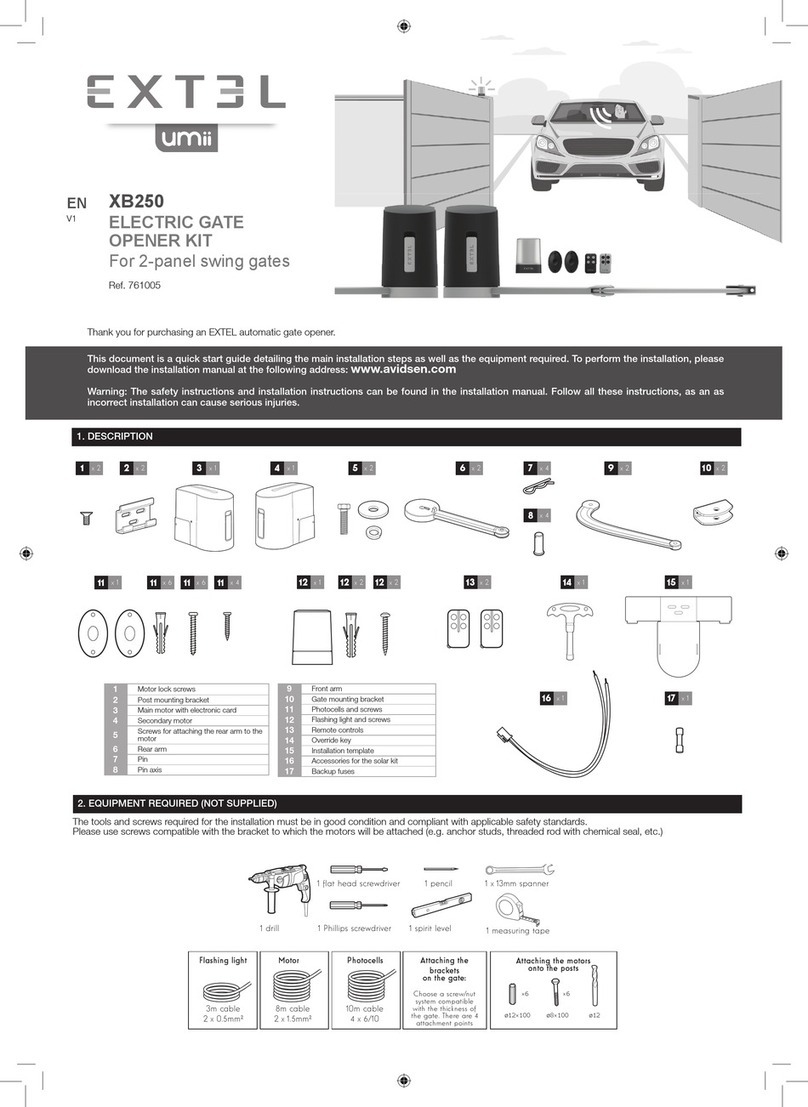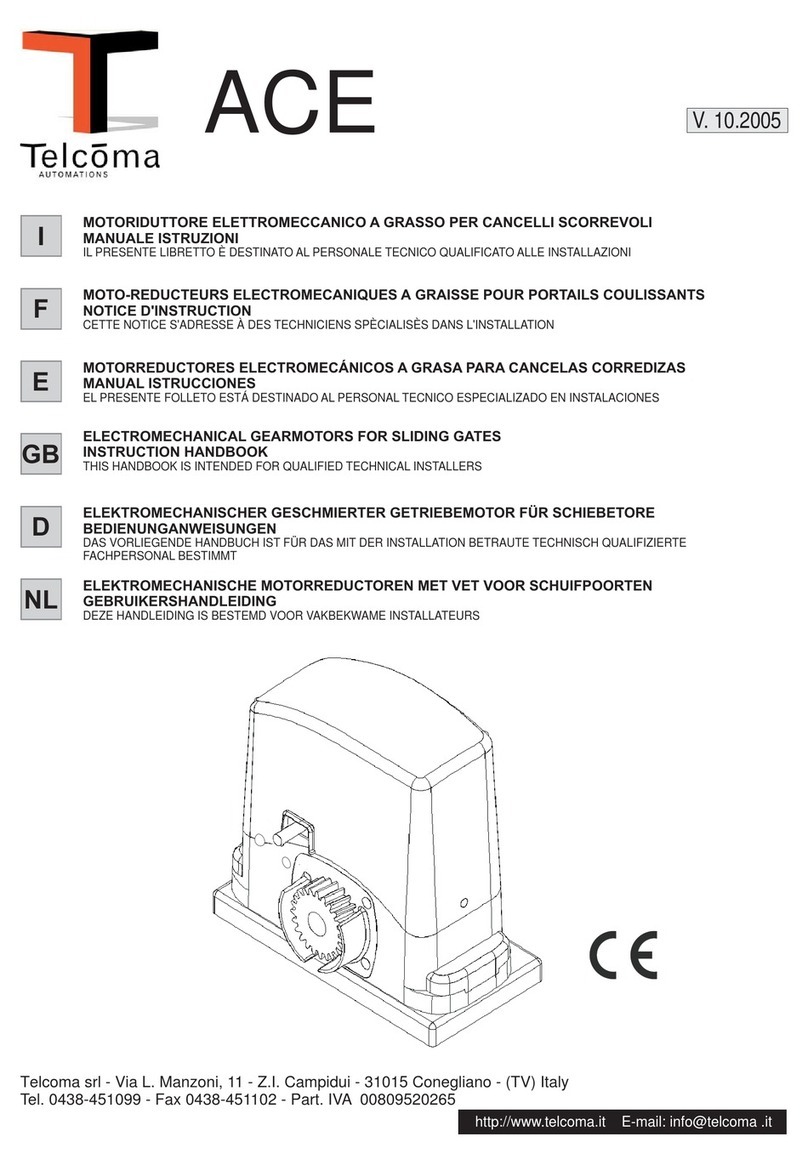
GB
Check that your gate is in generally good condition (hinges,slide rails and
supports allow movement with the automatic control elements attached).
This movement should be done easily when operated manually.
Fig. 1: Electrical installation preparation (instructions p.10)
Fig. 2: Horizontal positioning of the brackets (instructions p.11)
Measure «C», determine «A» and hole number from the table
Fig. 3: Vertical positioning of the brackets (instructions p.11)
Mark a line on the pillar 5 cm above the gate’s point of force
Fig. 4: Attach the brackets and install the motor (instructions p.12)
Fig. 5: Motor unlocked,open the gate leaf, then place the stops (instructions p.12)
Fig. 6: Electrical connection (instructions p.14-15)
Fig. 7: Connection to the electrical network (instructions p.15 et 10)
Fig. 8: Automatic practice runtime (instructions p.16)
• Reset for 2s •P1/Set for 2s
Fig. 9: Practice run using the remote controls (instructions p.17)
• P2/Radio during 2s •press the remote control •LD2 flashes.
Fig.10: Adjustments to optimise the operation of your automatic controls
(instructions p.17)
LED:Adjustment of the backlight’s sensitivity to ambient lighting
FOR: Force
PAU: Set pause time during automatic closure mode
OBS: Reaction time on the obstacle (e.g. for windy areas)
DEL: Closing lag between the overlapping and overlapped gate leaves
OVL: Obstacle detection. Sensitivity
Controleer de algemene goede staat van uw hek (scharnieren of geleiders,
steunen die de te schroeven en bewegende elementen van de automatische deurope-
ning kunnen dragen) Het hek moet eenvoudig met de hand bewogen kunnen worden
Fig. 1: Voorbereidende werkzaamheden voor de elektrische installatie
(handleiding blz. 10)
Fig. 2: Horizontale plaatsing van de bevestigingsbeugels (handleiding blz. 11)
Meet “C”, bepaal “A” en het gatnummer dat in de tabel vermeld staat
Fig. 3: Verticale plaatsing van de bevestigingsbeugels (handleiding blz. 11)
Teken een streep af op de steunpilaar, 5 cm boven het krachtpunt van het hek
Fig. 4: Bevestig de beugels en installeer de motor (handleiding blz.12)
Fig. 5: Open de vleugel met ontgrendelde motor en breng de aanslagen aan
(handleiding blz. 12)
Fig. 6: Elektrische aansluiting (handleiding blz.14-15)
Fig. 7: Aansluiting op het elektrische netwerk (handleiding blz.15 en 10)
Fig. 8: Auto-learn proces van de slagtijden (handleiding blz.16)
• Reset gedurende 2 s •P1/Set gedurende 2 s
Fig. 9: Auto-learn proces van de afstandsbedieningen (handleiding blz. 17)
• P2/Radio gedurende 2 s •druk op de afstandsbediening •LD2 knippert.
Fig.10: Afstellingen voor een optimale werking van de automatische deuropening
(handleiding blz. 17)
LED:Afstelling schemerstand van de achtergrondverlichting
KRA: Kracht
PAU: Pauzetijd tijdens de stand automatische sluiting
OBS: Reactietijd bij obstakels (bij winderige zone bijvoorbeeld)
VER:Verschil bij sluiting tussen de bedekte en bedekkende vleugel
OVL: Detectie van obstakels. Gevoeligheid
NL
D
Überprüfen Sie den allgemeinen guten Zustand IhresTors (Scharniere oder
Schienen,die Baueteile,die die Elemente der angeschraubten und sich bewegenden
automatisierten Betriebseinheit aufnehmen können)
Es muss leicht beweglich sein, wenn es von Hand betätigt wird.
Fig. 1: Vorbereitung der elektrischen Installation (Broschüre S. 10)
Fig. 2: Horizontale Positionierung der Befestigungsklauen (Broschüre S. 11)
Messen Sie „C“, bestimmen Sie „A“ und die Lochzahl mit Hilfe der Tabelle
Fig. 3: Vertikale Positionierung der Befestigungsklauen (Broschüre S. 11)
Markieren Sie 5 cm unter dem Kraftangriffspunkt des Tors einen Strich auf
dem Pfosten
Fig. 4: Befestigen Sie die Klauen und montieren Sie den Motor (Broschüre S. 12)
Fig. 5: Entriegelter Motor, Flügel öffnen und nachfolgend die Anschläge anbringen
(Broschüre S. 12)
Fig. 6: Elektrischer Anschluss (Broschüre S. 14-15)
Fig. 7: Anschluss an das Stromnetz (Broschüre S. 15 und 10)
Fig. 8: Eigenstudium der Bewegungszeiten (Broschüre S.16)
• Reset während 2 s •P1/Set während 2 s
Fig. 9: Erlernen der Funktionsweise der Fernbedienungen (Broschüre S.17)
• P2/Radio 2 s •lang auf der Fernbedienung drücken •LD2 blinkt auf.
Fig.10: Einstellungen zur Funktionsoptimisierung Ihrer automatisierten
Betriebseinheit (Broschüre S. 17)
LED : Dämmerregulierung der Rückleuchten
FOR : Kraft
PAU : Pausenzeitfenster bei dem automatischen Schließmodus
OBS : Reaktionszeit bei Hindernis (beispielsweise inWind ausgesetzten Gebieten)
DEL : Schließverzögerung zwischen bedecktem und deckenden Flügel
OVL : Hindernisdetektion. Sensibilität
SK
Skontrolujte, či je vaša brána vo všeobecne dobrom stave (závesy, vo-
diace lišty a podpery umožňujú pohyb pripojených automaticky ovládaných
prvkov). Tento pohyb by mal byť pri manuálnej prevádzke jednoduchý.
Fig. 1 : Príprava elektrickej inštalácie (pokyny na str. 10)
Fig. 2 : Horizontálne umiestnenie nosníkov (pokyny na str. 11)
Zmerajte «C», určite «A», počet otvorov podľa tabuľky
Fig. 3 : Vertikálne umiestnenie nosníkov (pokyny na str. 11)
Na stĺpiku označte čiaru 5 cm nad pôsobiskom sily brány
Fig. 4 :FPripojte nosníky a nainštalujte motorček (pokyny na str. 12)
Fig. 5 :Odblokujte motorček, otvorte krídlo brány a následne umiestnite zarážky
(pokyny na str. 12)
Fig. 6 : Elektrické pripojenie (pokyny na str. 14 - 15)
Fig. 7 : Pripojenie k elektrickej sieti (pokyny na str. 15 a 10)
Fig. 8 : Automatické spustenie programu (pokyny na str. 16)
•Reštart po dobu 2 s •P1/Nastavte na 2 s
Fig. 9 : Spustite pomocou diaľkového ovládania (pokyny na str. 17)
•
P2/Stlačte tlačidlo rádio na 2 s •stlačte diaľkový ovládač •Rozsvieti sa kontrolk LD2
Fig.10: Nastavenia pre optimalizáciu prevádzky automatického ovládania (po-
kyny na str. 17)
LED: Nastavenie citlivosti podsvietenia v závislosti od osvetlenia okolia.
FOR: Vynútiť.
PAU: Nastavenie doby pauzy počas režimu automatického zavierania.
OBS: Čas reagovania na prekážku (napr. veterné oblasti).
DEL: Oneskorenie zavierania medzi prekrývaným a prekrytým krídlom brány.
OVL: Detekcia prekážky. Citlivosť.
CZ
Zkontrolujte, zda je vaše brána v obecně dobrém stavu (čepy, vodící lišty
a podpěry umožňují pohyb připojených automaticky ovládaných prvků).
Tento pohyb by se měl při ručním provozu provést snadno.
Fig. 1 : Příprava elektrické instalace (pokyny na str. 10)
Fig. 2 : Horizontální umístění nosníků (pokyny na str. 11)
Změřit «C», určit «A», počet otvorů dle tabulky
Fig. 3 : Vertikální umístění nosníků (pokyny na str. 11)
Na sloupku označte čáru 5 cm nad působištěm síly brány
Fig. 4 :Připojte nosníky a nainstalujte motor (pokyny na str. 12)
Fig. 5 :Odemkněte motor, otevřete křídlo vrat, potom umístěte zarážky (pokyny na str. 12)
Fig. 6 : Elektrické připojení (pokyny na str. 14-15)
Fig. 7 : Připojení k elektrické síti (pokyny na str. 15 a 10)
Fig. 8 : Automatický praktický běh programu (pokyny na str. 16)
•Restart po dobu 2 s •P1/Nastavte na 2 s
Fig. 9 : Spustit s použitím dálkového ovládání (pokyny na str. 17)
•P2/RADIO po dobu 2 s •stiskněte dálkový ovladač •Rozbliká se kontrolka LD2.
Fig.10: Nastavení pro optimalizaci provozu vašeho automatického ovládání.
(pokyny na str. 17)
LED: Nastavení citlivosti podsvícení v závislosti na okolním osvětlení.
FOR: Vynutit
PAU: Nastavení délky pauzy během režimu automatického zavírání
OBS: Reakční čas na překážku (např. větrné oblasti)
DEL: Opoždění zavírání mezi překrýváním a překrytými křídly vrat
OVL: Detekce překážky. Citlivost.
PL
Sprawdź, czy Twoja brama jest w ogólnie dobrym stanie (czy zawiasy,
szyny prowadnic i podpory umożliwiają ruch po przymocowaniu automatyc-
znych elementów sterowniczych).
Ruch ten powinien odbywać się bez utrudnień przy sterowaniu ręcznym.
Fig. 1 : Przygotowanie instalacji elektrycznych (instrukcja str.10)
Fig. 2 : Poziome umieszczenie wsporników (instrukcja str.11)
Zmierz «C», określ «A» i liczbę otworów, posługując się tabelą
Fig. 3 : Pionowe umieszczenie wsporników (instrukcja str.11)
Zaznacz linię na larze 5 cm powyżej punktu przyłożenia siły na bramie
Fig. 4 :Zamontuj wsporniki i zainstaluj silnik (instrukcja str.12)
Fig. 5 :Po odblokowaniu silnika, otwórz skrzydło bramy, a następnie umieść
ograniczniki (instrukcje str.12)
Fig. 6 : Instalacja elektryczna (instrukcja str.14-15)
Fig. 7 : Podłączenie do sieci elektrycznej (instrukcja str.15 i 10)
Fig. 8 : Automatyczne ćwiczenie czasu wykonania polecenia (instrukcja str.16)
• Resetuj na 2 sekundy •P1/Ustaw na 2 sekundy
Fig. 9 : Przećwicz obsługę z użyciem pilota (instrukcja str.17)
•Tryb 2/Radio przez 2 sekundy •naciśnij pilota •LD2 migocze.
Fig.10: Dostosowanie w celu optymalizacji działania automatycznych systemów
sterowniczych (instrukcja str.17)
LED: Dostosowanie czułości przeciwoświetlenia do wrażliwości oświetlenia miejscowego
FOR: Siła
PAU: Ustaw czas przerwy dla trybu zamykania automatycznego
OBS: Czas reakcji na przeszkodę (np. dla obszarów wietrznych)
DEL: Opóźnienie zamknięcia bramy między skrzydłami: nakładającym się i
nakładanym na
OVL: Wykrywanie przeszkód. Czułość
Découvrez nos produits sur : www.cfi-extel.com, & .
Notice intégrale sur le CD fourni ou à télécharger sur :
Istruzioni integrale sul CD fornito o a trasferire su:
Instrucciones íntegro sobre el CD proporcionado o a cargar a distancia sobre:
Manual integral sobre o CD fornecido ou fazer o download sobre:
Integral manual on provided CD or to download on:
Volledige korte kleurenhandleiding op geleverd CD of om te downloaden op:
Integrale Gebrauchsanweisung auf CD geliefertem oder zu laden auf : www.cfi-extel.com
• France : Hotline :
0 892 350 069 (0,337€TTC/min)
• Italia :Assistenza Tecnica : +39 02 96488273
assistenza@cfi-extel.com
• España :Asistencia técnica : 902 109 819
sat-hotline@cfi-extel.com
• Portugal : Serviço de apoio ao cliente :
707 201 138






